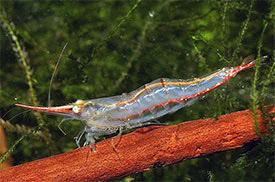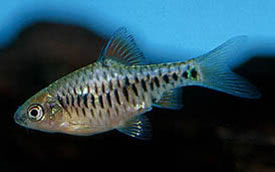
 Magyarul / Hungarian
Magyarul / Hungarian



- Scientific name: Caridina gracilirostris
- Synonyms: Palaemon scarletti
- Common name: Red Nose Shrimp, Rhino Shrimp, Rudolph Shrimp, Mosquito Shrimp
- Group: Freshwater invertebrates
- Habitat: Asia; India, Southeast Asia
- Size: 3.5-4 cm
- Biotope: Mostly found at river estuaries and in magrove marshes where the freshwater meets the saltwater.
- Social behavior: A very peaceful shrimp that should be kept in a small group of at least 6 individuals. Do not keep with any large or aggressive fish that can eat them.
- Diet: Omnivorous; they basically eat algae and other plant matters (appreciates dried nettle leaves), but in the aquarium they will eat other fish foods too.
- Breeding: Very rare in aquarium
- Tank: Minimum 30 litres
- Population: 6-8 shrimp for 40 litres
- Decoration: Provide them a densely planted mature aquarium with many hiding places. The substrate can be gravel.
- Temperature: 20-28 °C
- pH: 6.5-7.5
- Hardness: 8-15 NK°
- Lifespan: 1-3 years
Description: Red Nose Shrimps have similar shape to other species in the Caridina genus, but have much longer, red to pink colored rostrum that is the reason for their common name. The dorsal side of the rostrum is covered with larger and more dispersed spikes, while on the ventral side there are small and tight spikes. The light colored eyes are found on a relatively long occular pedoncule which gives the shrimp an incredible appearance. The rest of the body is transparent sometimes with a few blue shades. There is a red line running inside of their body from the head to the tail, but the intensity of the red can vary from shrimp to shrimp. Healthy shrimps always have transparent body, however sick, or stressed specimens turn noticeably milky, and they usually die soon. For that very reason always buy shrimp that do not show the milky white coloration. Like many invertebrates, Red Nose Shrimps are very sensitive to copper that is found in many fish medication, and they also sensitive to ammonia, nitrite, nitrate, and chlorine. Most of the specimens available in the stores are wild caught.
Females are a little larger and also have larger swimmerets under their abdomen than males. Males have red lateral lines running down on their body, while on females these lines are less colorful. About every 8 weeks the female incubates several hundred little green eggs. Brackish water or saltwater is required to raise the newly hatched larvae. The young exist in a drifting, planktonic state before changing into a miniature adult-like form after several molts. Once the small shrimps become 5 mm long, they can be slowly accustomed to freshwater.


























